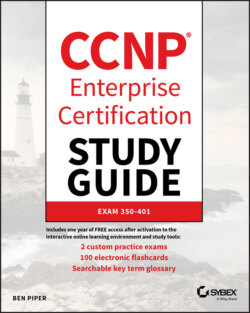Читать книгу CCNP Enterprise Certification Study Guide: Implementing and Operating Cisco Enterprise Network Core Technologies - Ben Piper, David Higby Clinton - Страница 85
Exam Essentials
ОглавлениеBe able to determine the root bridge, root ports, and designated ports for any Spanning Tree topology. Because a layer 2 loop can bring down a network, you must be able to understand what Spanning Tree will do before you configure it or add a new switch to an existing network. Experimenting is a recipe for disaster!
Understand the differences among PVST+, RPVST+, and MST. PVST+ is the original Cisco implementation of the timer-based 802.1D Spanning Tree specification. RPVST+ doesn't use timers, introduces link types, and has a faster convergence time. (R)PVST+ creates a separate Spanning Tree instance for each VLAN. MST lets you map multiple VLANs to a single MST instance, which is useful if you have a large number of VLANs.
Know how to manipulate active and allowed VLANs on a trunk. By default, all VLANs (1-4094) are allowed on a trunk. In order for a VLAN to be allowed and active on one end of a trunk, the VLAN must exist on the switch and not be shut down. If a VLAN is shut down, it will show as allowed but not active. If a VLAN is pruned or blocked, it will show as neither allowed nor active.
Be able to configure all Spanning Tree modes. Although PVST+ is deprecated, its configuration commands are similar to RPVST+, and you may still encounter PVST+ on older gear. Be able to configure (R)PVST+ and MST to customize the root bridge, root ports, and designated ports.
Understand the interactions between RPVST+ and MST. Although this is something that you're more likely to see on an exam than in real life, practicing running RPVST+ and MST concurrently in your lab will solidify your understanding of both. In particular, understand how MST simulates RPVST+.
